Simulation and Experimental Study on the Effect of Edge Radius on the Cutting Condition of Carbide Inserts
Abstract
1. Introduction
2. Tool-Cutting Simulation
2.1. Material Constitutive Model
2.2. Finite Element Model
2.3. Simulation Results and Analysis
2.3.1. Effect of Edge Radius on Cutting Force
2.3.2. Effect of Edge Radius on Cutting Temperature
3. Experiment
3.1. Cutting Edge Preparation Principle by STP
3.2. Characterization and Measurement of Cemented Carbide Insert
3.3. Cutting Edge Preparation Experiment of Cemented Carbide Insert
3.4. Cutting Experiment
4. Results and Discussion
4.1. Cutting Edge Preparation Experiment Results
4.2. Cutting Experimental Results and Verification
4.2.1. Effect of Edge Radius on Cutting Force
4.2.2. Effect of Edge Radius on Cutting Temperature
4.2.3. Effect of Edge Radius on Cutting Quality
5. Conclusions
Author Contributions
Funding
Data Availability Statement
Conflicts of Interest
References
- Yuan, X.M.; Cao, W.J.; Zhang, G.; Wang, G.X.; Zhou, J.; Tang, Z.M. Construction of cutting force prediction model of honeycomb core with dagger knife. Manuf. Tech. Mach. Tools 2021, 9, 79–85. [Google Scholar]
- Barbosa, M.G.C.B.; Hassui, A.; De Oliveira, P.A.; Borges, W.F.A. Influence of feed and cutting-edge radius on tool wear, surface roughness, and electric current in milling of VP20TS steel. Int. J. Adv. Manuf. Technol. 2023, 129, 3609–3626. [Google Scholar] [CrossRef]
- Fulemova, J.; Janda, Z. Influence of the Cutting Edge Radius and the Cutting Edge Preparation on Tool Life and Cutting Forces at Inserts with Wiper Geometry. Procedia Eng. 2014, 69, 565–573. [Google Scholar] [CrossRef]
- Gonçalves Júnior, M.; de Angelo Sanchez, L.E.; França, T.V.; Fortulan, C.A.; Da Silva, R.H.L.; Foschini, C.R. Analysis of the tool nose radius influence in the machining of a green ceramic material. Int. J. Adv. Manuf. Technol. 2019, 105, 3117–3125. [Google Scholar] [CrossRef]
- Peter, P.; Boris, P.; Tomáš, V.; Jozef, P.; Marek, V.; Vladimír, Š. Cutting edge radius preparation. Mater. Today Proc. 2020, 22, 212–218. [Google Scholar] [CrossRef]
- Zhang, S.; Zou, B.; Liu, Y.; Wang, Y.; Huang, C.; Liu, Z. Edge preparation and quality of carbide cutting inserts treated by wet micro-abrasive blasting. Int. J. Adv. Manuf. Technol. 2018, 96, 2307–2318. [Google Scholar] [CrossRef]
- Deng, Q.; Dong, R.; Sun, L.; Zhang, C.; Lyu, B.; Wang, X.; Yuan, J. Edge preparation of carbide cutting tool based on abrasive water jet of fluid self-excited oscillating characteristics. Int. J. Adv. Manuf. Technol. 2023, 129, 2661–2676. [Google Scholar] [CrossRef]
- Hartig, J.; Kirsch, B.; Aurich, J.C. Analysis of the grinding wheel wear and machining result during cutting edge preparation with elastic bonded grinding wheels. J. Manuf. Process. 2022, 75, 181–202. [Google Scholar] [CrossRef]
- Li, X.; Huang, X.; Ming, Y.; Zhou, D.D.; Cai, Y.H. Carbide twist drill surface polishing and cutting edge passivating based on magnetic field-assisted shear thickening. Int. J. Adv. Manuf. Technol. 2023, 126, 5649–5664. [Google Scholar] [CrossRef]
- Fu, X.; Zou, B.; Liu, Y.; Huang, C.; Yao, P. Edge micro-creation of Ti (C, N) cermet inserts by micro-abrasive blasting process and its tool performance. Mach. Sci. Technol. 2019, 23, 951–970. [Google Scholar] [CrossRef]
- Chen, H.Y.; Wu, Z.C.; Hong, B.B.; Hang, W.; Zhang, P.; Cao, X.; Xu, Q.; Chen, P.; Chen, H.; Yuan, J.; et al. Study on the affecting factors of material removal mechanism and damage behavior of shear rheological polishing of single crystal silicon carbide. J. Manuf. Process. 2024, 112, 225–237. [Google Scholar] [CrossRef]
- Li, M. Basic Research on Shear Thickening and Polishing Methods. Ph.D. Thesis, Hunan University, Changsha, China, 2015. [Google Scholar]
- Wang, L.; Wu, M.X.; Chen, H.Y.; Hang, W.; Wang, X.; Han, Y.; Chen, H.; Chen, P.; Beri, T.H.; Luo, L.; et al. Damage evolution and plastic deformation mechanism of preparation layer during shear rheological polishing of polycrystalline tungsten. J. Mater. Res. Technol. 2024, 28, 1584–1596. [Google Scholar] [CrossRef]
- Lyu, B.; Ke, M.; Fu, L.; Duan, S.; Shao, Q.; Zhou, Y.; Yuan, J. Experimental study on the brush tool–assisted shear-thickening polishing of cemented carbide insert. Int. J. Adv. Manuf. Technol. 2021, 115, 2491–2504. [Google Scholar] [CrossRef]
- Shao, L.Y.; Ke, M.F.; Wang, J.H.; Lyu, B.H.; Wang, X.; Yuan, J.L. Experimental study on flexible fiber assisted stress rheological preparation and polishing of complex edge of cemented. Diam. Abras. Eng. 2022, 42, 1–9. [Google Scholar]
- Chan, J.; Koshy, P. Tool edge honing using shear jamming abrasive media. CIRP Ann. 2020, 69, 289–292. [Google Scholar] [CrossRef]
- Shao, W.P.; Zhang, T.P. Process parameters optimization of high-speed milling 7075 aluminum alloy with nano-diamond coated tool. Diam. Abras. Eng. 2022, 42, 473–480. [Google Scholar]
- Zhang, X.; Cheng, Y.; Lv, M.; Miao, X.; Xie, C. Study on high-speed vibration cutting of titanium alloy considering cutting edge radii. Int. J. Adv. Manuf. Technol. 2023, 124, 3327–3342. [Google Scholar] [CrossRef]
- Ma, H.; Tang, A.; Xu, S.; Li, T. Finite element simulation of bending thin-walled parts and optimization of cutting parameters. Metals 2023, 13, 115. [Google Scholar]
- Sahoo, P.; Patra, K.; Singh, V.K.; Gupta, M.K.; Song, Q.; Mia, M.; Pimenov, D.Y. Influences of TiAlN coating and limiting angles of flutes on prediction of cutting forces and dynamic stability in micro milling of die steel (P-20). J. Mater. Process. Technol. 2020, 278, 116500. [Google Scholar] [CrossRef]
- Kabwe, E.; Karakus, M.; Chanda, E.K. Isotropic damage constitutive model for time-dependent behaviour of tunnels in squeezing ground. Comput. Geotech. 2020, 127, 103738. [Google Scholar] [CrossRef]
- Xu, Z.; Song, Y.; Liu, Z. Stress analysis and fatigue life prediction of contact wire located at steady arms in high-speed railway catenary system. IEEE Trans. Instrum. Meas. 2022, 71, 1–12. [Google Scholar] [CrossRef]
- Shen, W.; Xue, F.; Li, C.; Liu, Y.; Mo, X.; Gao, Q. Study on constitutive relationship of 6061 aluminum alloy based on Johnson–Cook model. Mater. Today Commun. 2023, 37, 106982. [Google Scholar] [CrossRef]
- Sirigiri, V.K.R.; Gudiga, V.Y.; Gattu, U.S.; Suneesh, G.; Buddaraju, K.M. A review on Johnson Cook material model. Mater. Today Proc. 2022, 62, 3450–3456. [Google Scholar] [CrossRef]
- Gurusamy, M.; Sriram, S. Investigations on the choice of Johnson–Cook constitutive model parameters for the orthogonal cutting simulation of inconel 718. J. Adv. Manuf. Syst. 2023, 22, 1–25. [Google Scholar] [CrossRef]
- Javidikia, M.; Sadeghifar, M.; Songmene, V.; Jahazi, M. On the impacts of tool geometry and cutting conditions in straight turning of aluminum alloys 6061-T6: An experimentally validated numerical study. Int. J. Adv. Manuf. Technol. 2020, 106, 4547–4565. [Google Scholar] [CrossRef]
- Akram, S.; Jaffery, S.H.I.; Khan, M.; Fahad, M.; Mubashar, A.; Ali, L. Numerical and experimental investigation of Johnson–Cook material models for aluminum (Al 6061-T6) alloy using orthogonal machining approach. Adv. Mech. Eng. 2018, 10, 1–14. [Google Scholar] [CrossRef]
- Zhuang, K.; Fu, C.; Weng, J.; Hu, C. Cutting edge microgeometries in metal cutting: A review. Int. J. Adv. Manuf. Technol. 2021, 116, 2045–2092. [Google Scholar] [CrossRef]
- Peng, B.Y.; Xu, D.; Wang, P.J. Simulation Effect of Tool Material and Angle on Cutting Force of 7075-T6 Aluminum Alloy. Tool Technol. 2023, 57, 131–134. [Google Scholar]

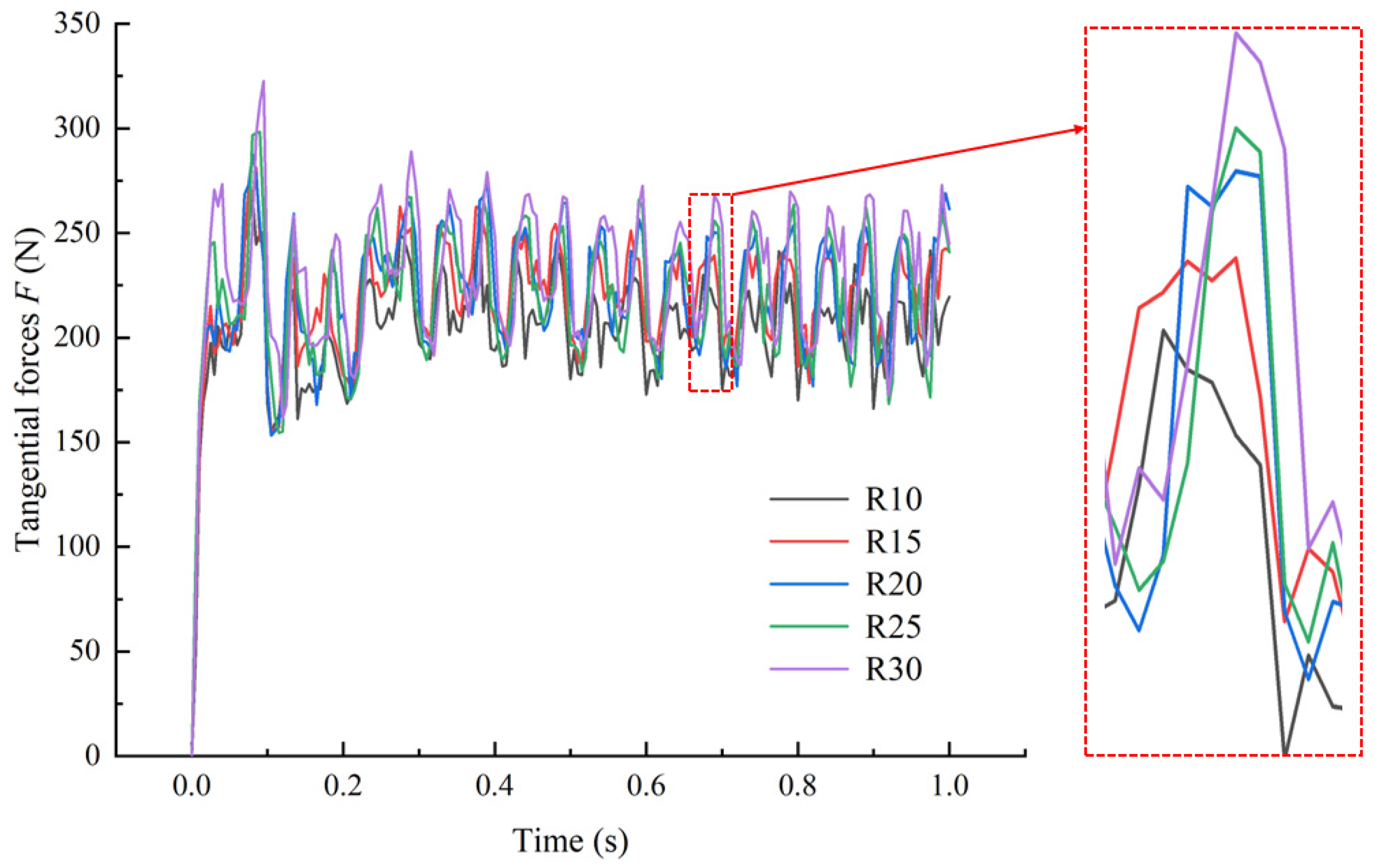
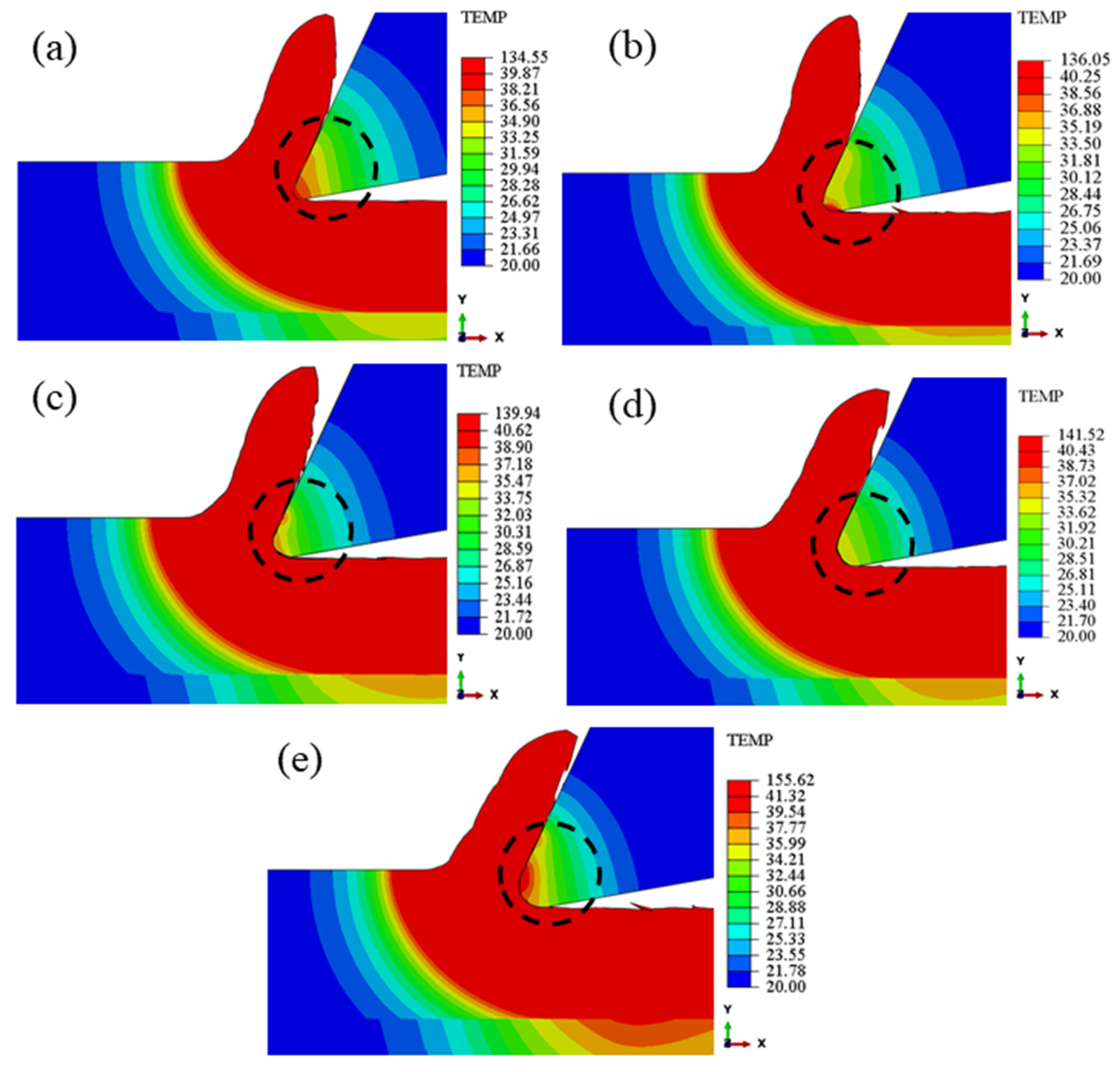


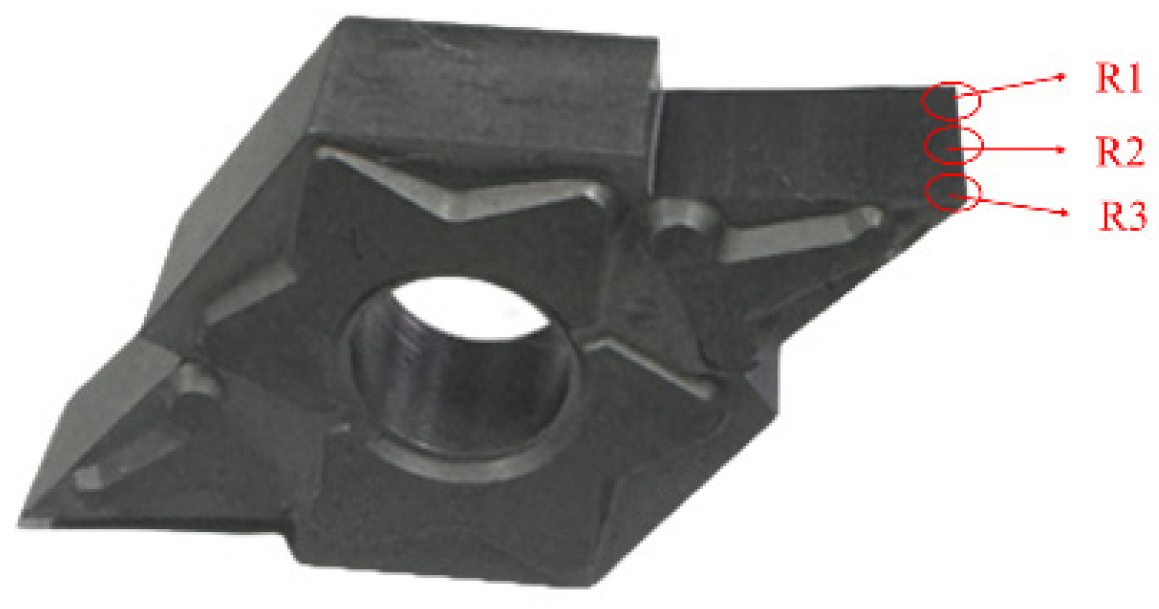
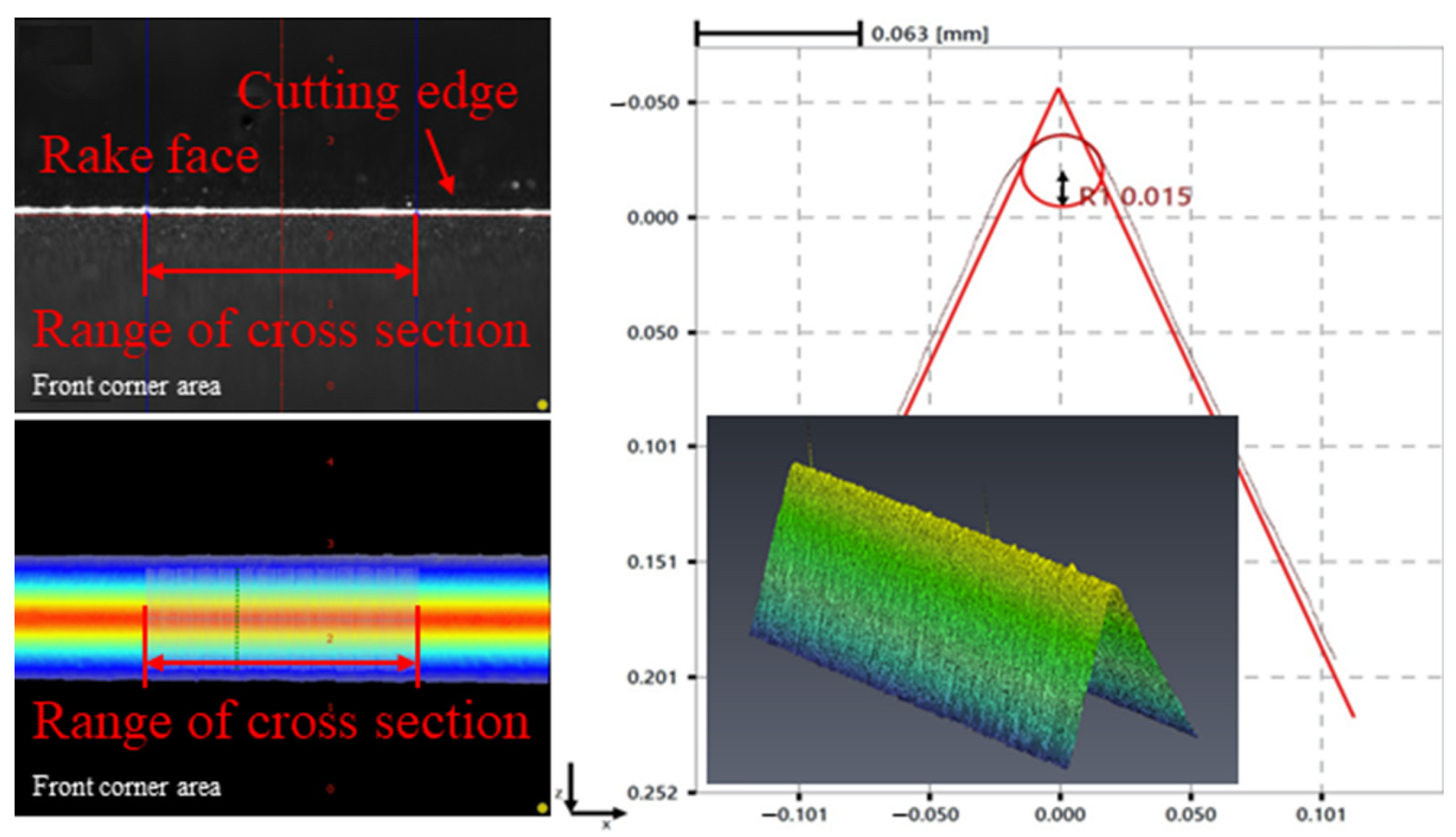

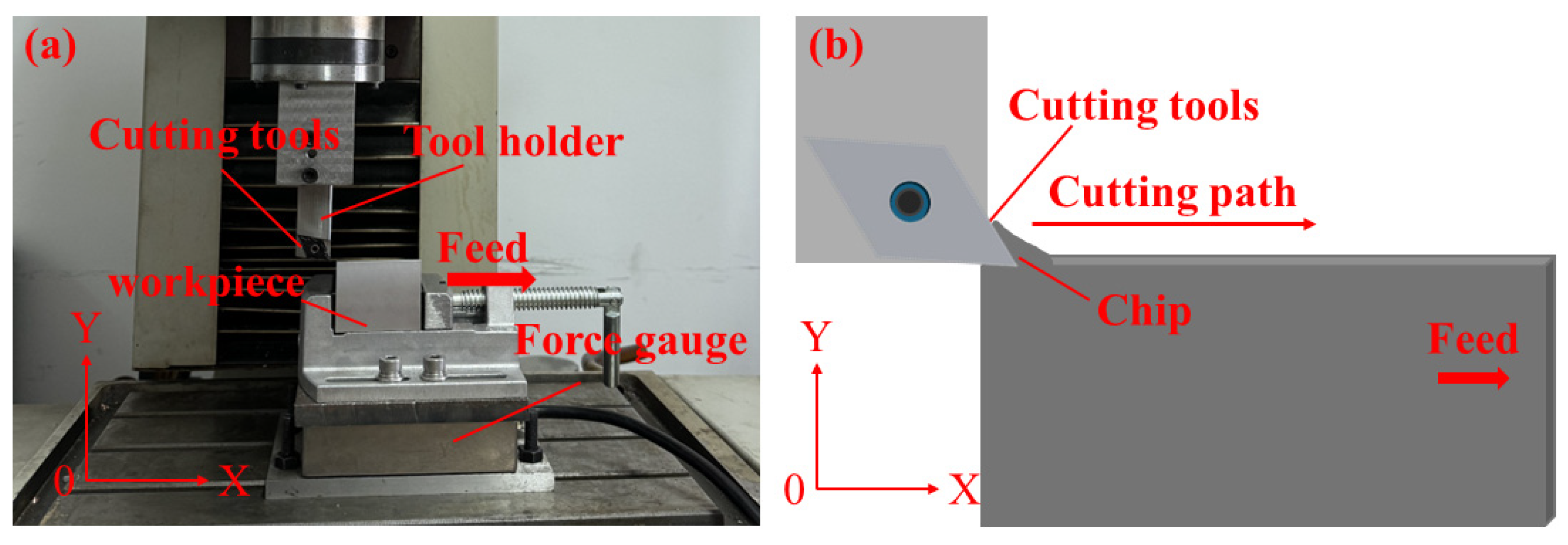

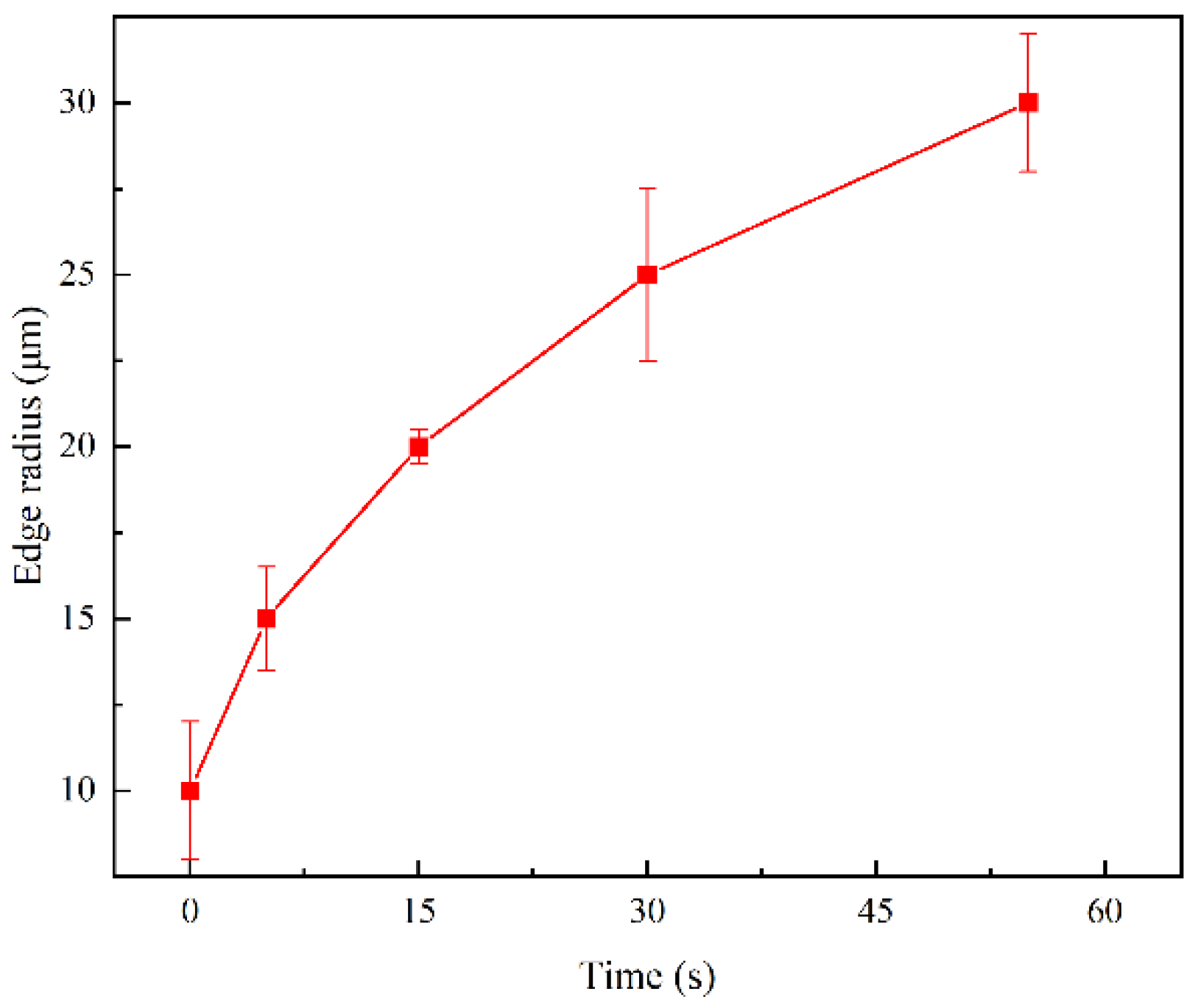
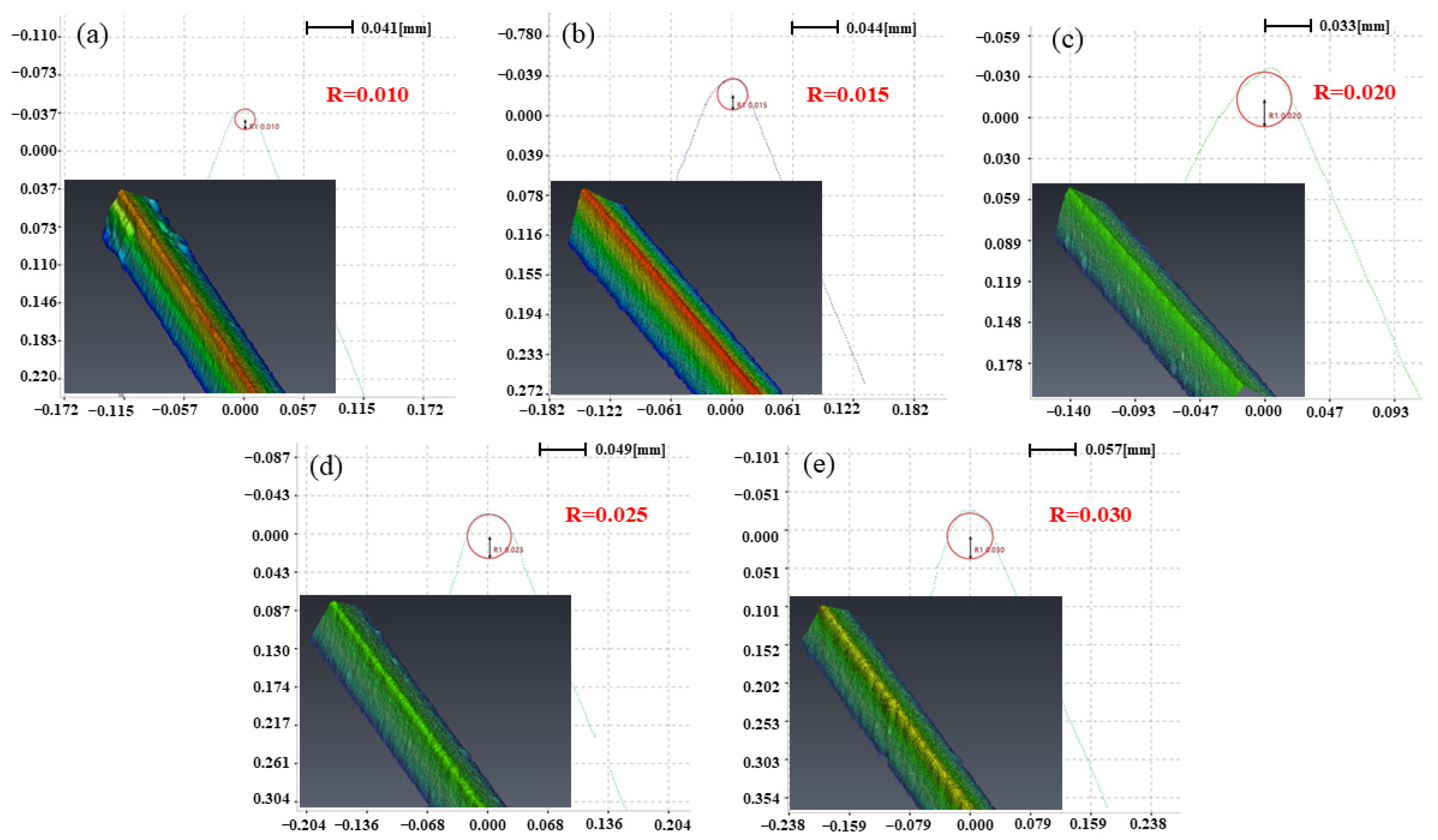

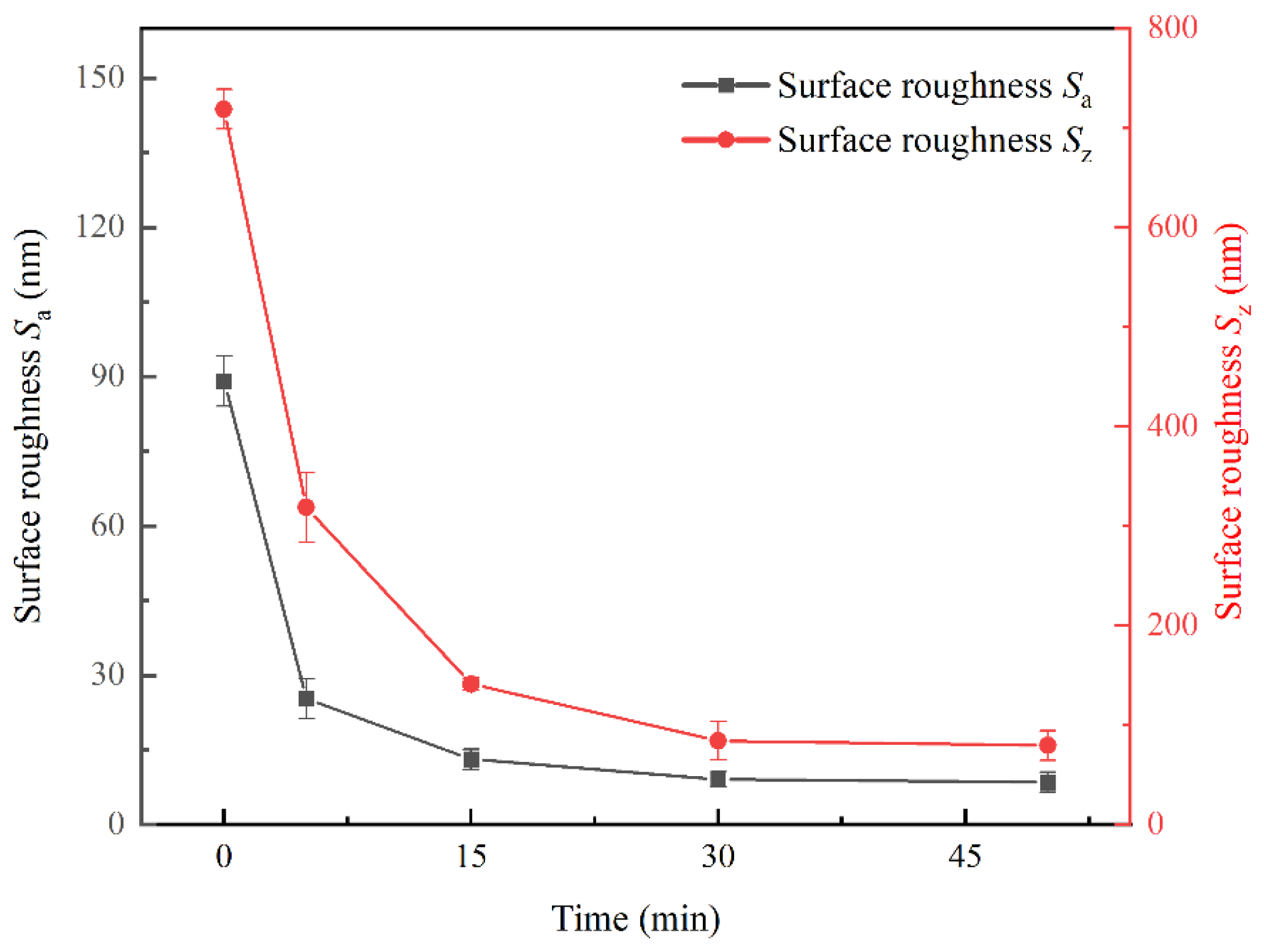

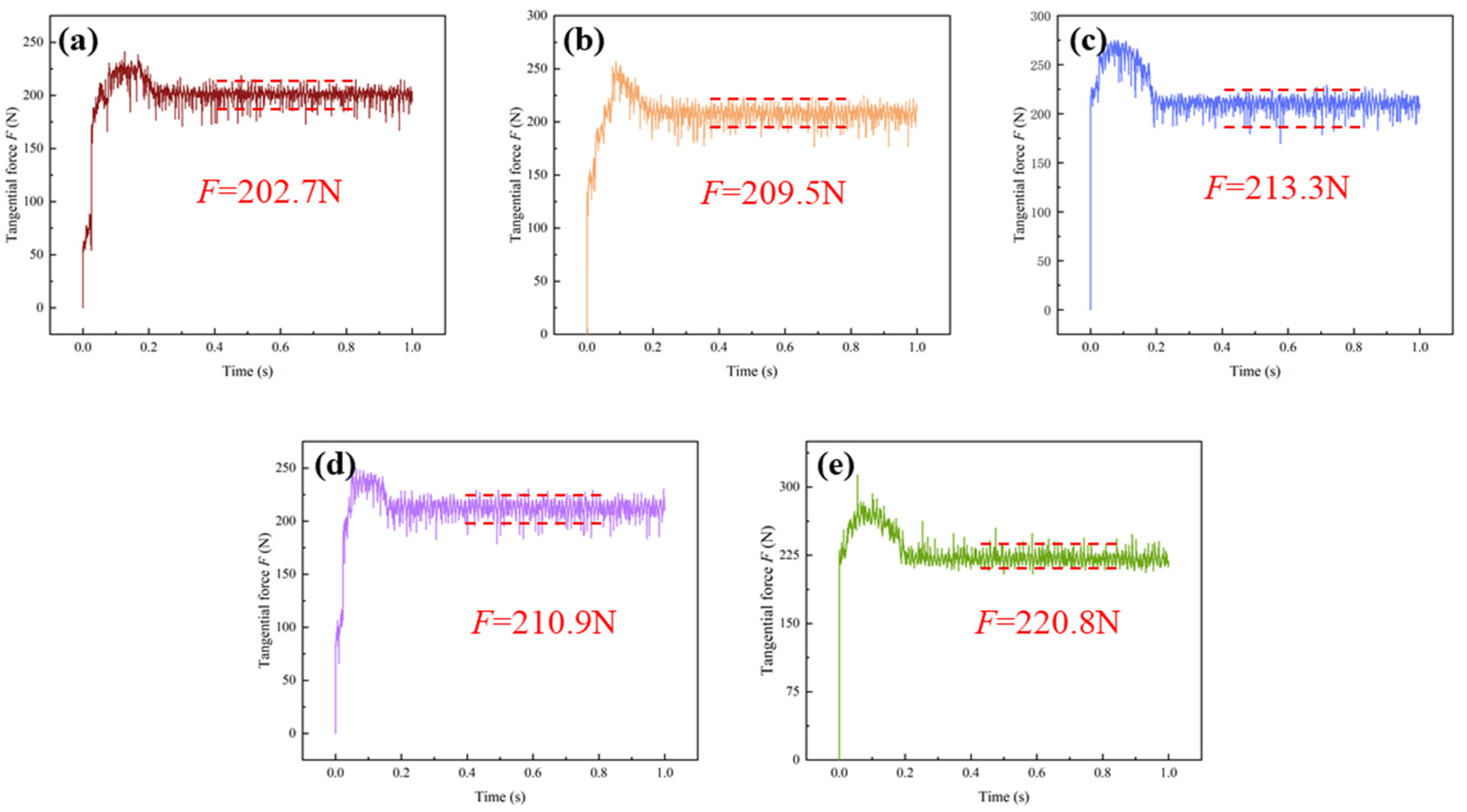

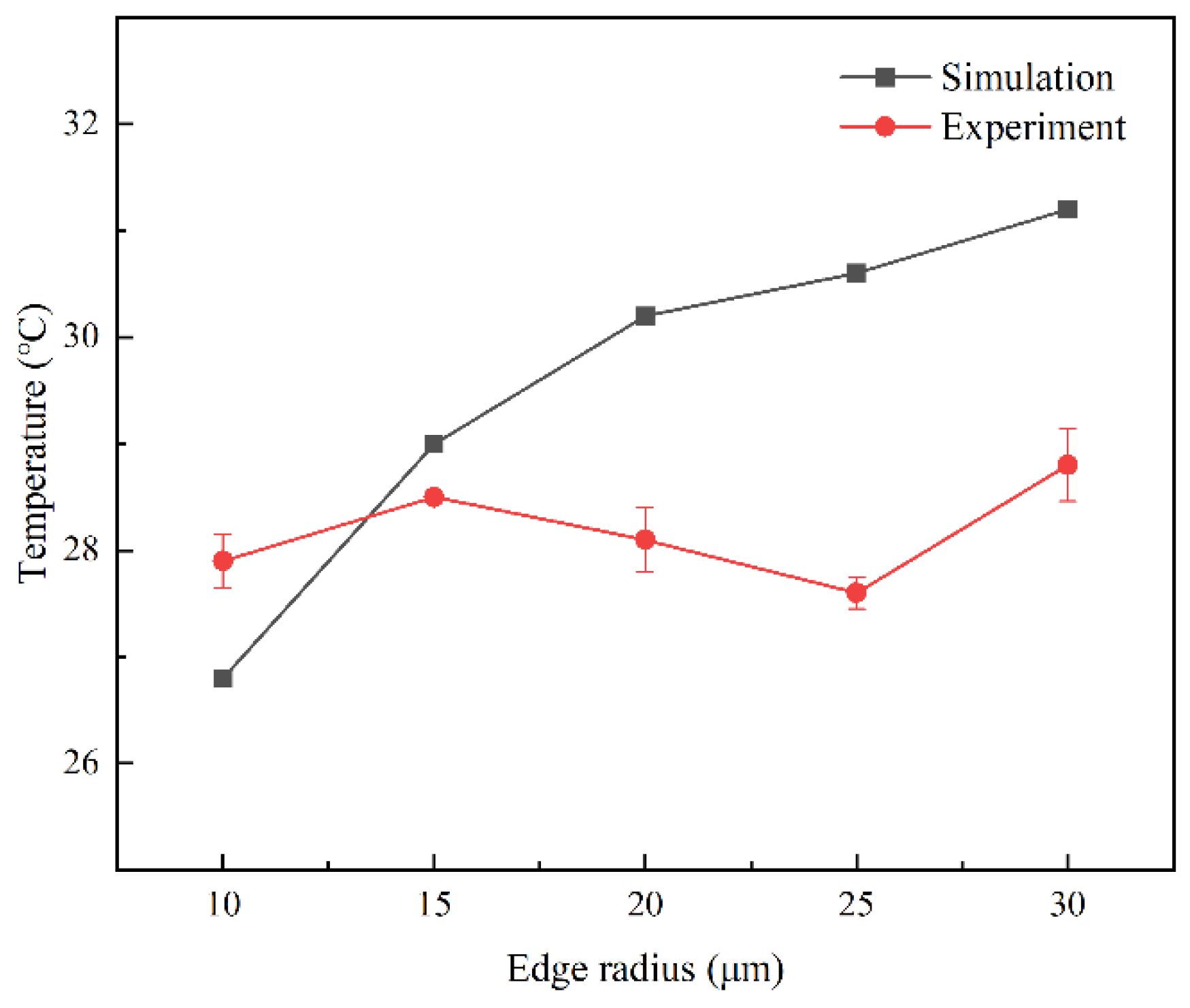
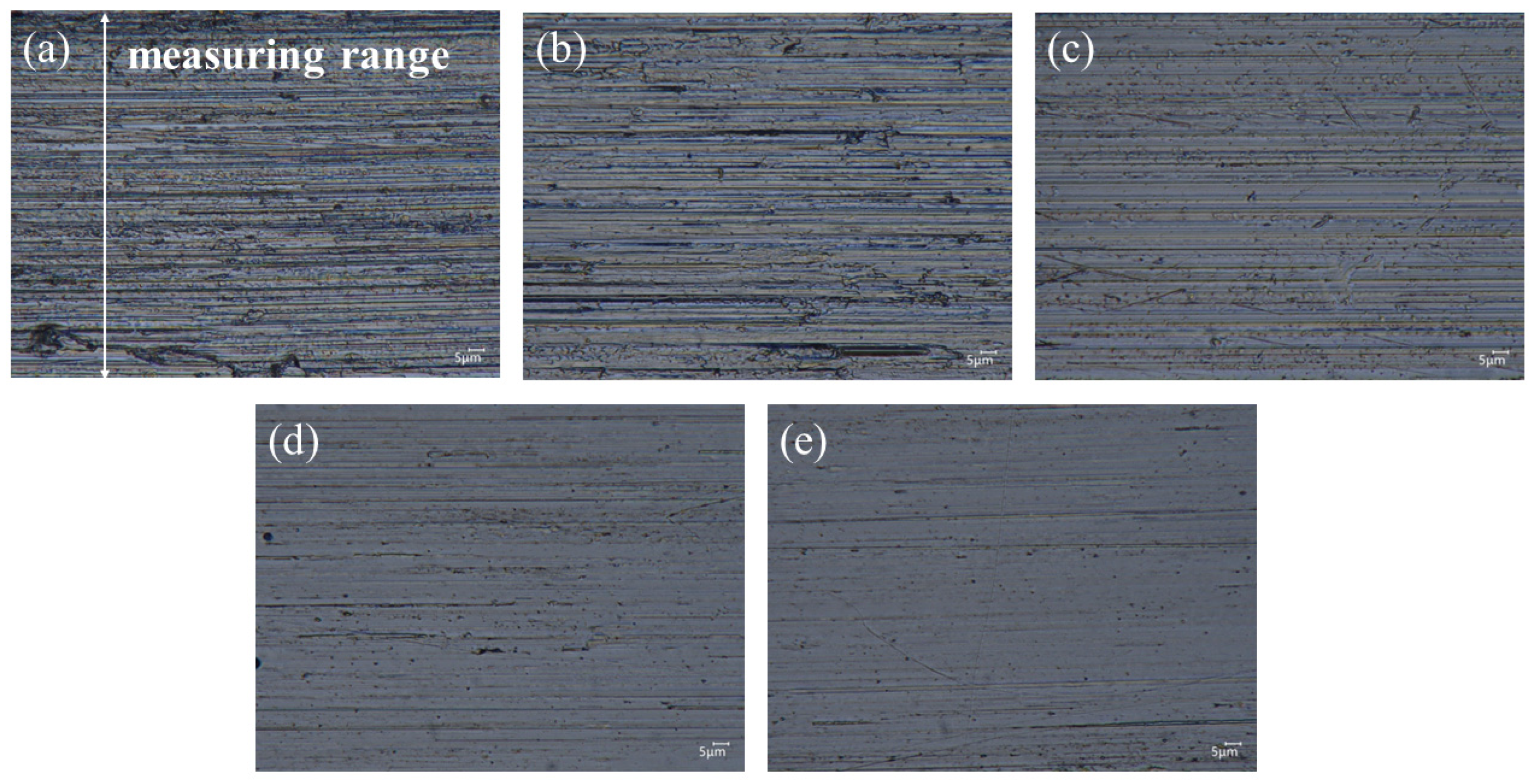
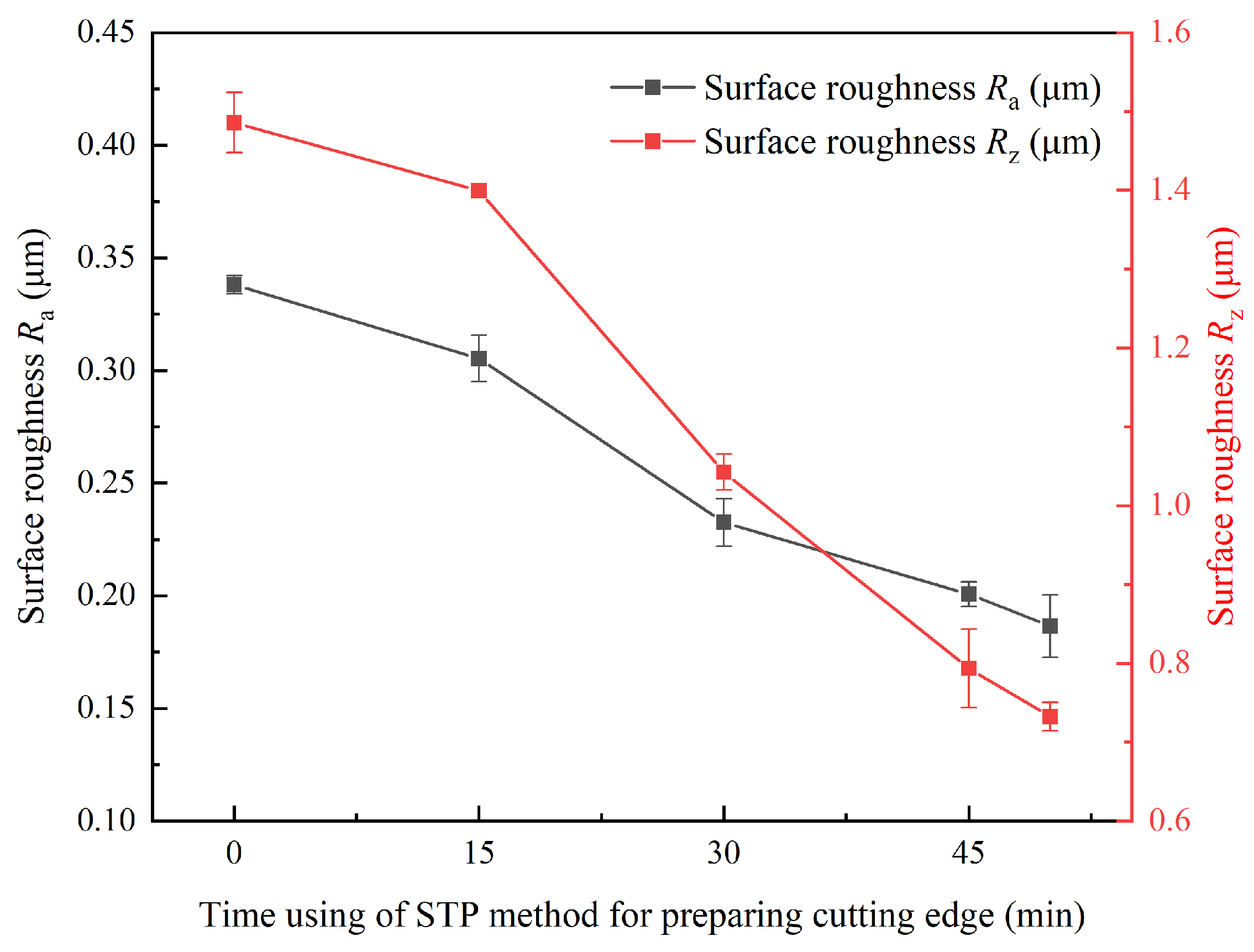
| Parameters of J–C Constitutive Equation | Parameters of J–C Damage Model | ||||||||
|---|---|---|---|---|---|---|---|---|---|
| A/MPa | B/MPa | n | C | m | D1 | D2 | D3 | D4 | D5 |
| 250 | 79.70 | 0.499 | 0.0249 | 1.499 | −0.77 | 1.45 | −0.47 | 0 | 1.6 |
| Material Properties | Tool | Workpiece |
|---|---|---|
| Density, kg/m3 | 14,500 | 2700 |
| Young’s modulus, GPa | 64 | 5.85 |
| Poisson’s ratio, v | 0.22 | 0.33 |
| Conductivity, W/(m·K) | 90 | 0.33 |
| Thermal expansion coefficient, K | 4.5 × 10−6 | 2.35× 10−5 |
| Specific heat capacity, J/(kg·K) | 220 | 896 |
| Cutting Condition | Parameter |
|---|---|
| Rake angle (°) | 30 |
| Clearance angle (°) | 5 |
| Cutting depth (mm) | 0.05 |
| Feed speed (m/min) | 0.6 |
| Edge radius (mm) | 0.01, 0.015, 0.02, 0.025, 0.03 |
Disclaimer/Publisher’s Note: The statements, opinions and data contained in all publications are solely those of the individual author(s) and contributor(s) and not of MDPI and/or the editor(s). MDPI and/or the editor(s) disclaim responsibility for any injury to people or property resulting from any ideas, methods, instructions or products referred to in the content. |
© 2024 by the authors. Licensee MDPI, Basel, Switzerland. This article is an open access article distributed under the terms and conditions of the Creative Commons Attribution (CC BY) license (https://creativecommons.org/licenses/by/4.0/).
Share and Cite
Chen, S.; Bao, Z.; Yan, Y.; Lyu, B.; Chen, H.; Hang, W.; Wang, J.; Zhao, W.; Yuan, J.; Wang, X. Simulation and Experimental Study on the Effect of Edge Radius on the Cutting Condition of Carbide Inserts. Machines 2024, 12, 216. https://doi.org/10.3390/machines12040216
Chen S, Bao Z, Yan Y, Lyu B, Chen H, Hang W, Wang J, Zhao W, Yuan J, Wang X. Simulation and Experimental Study on the Effect of Edge Radius on the Cutting Condition of Carbide Inserts. Machines. 2024; 12(4):216. https://doi.org/10.3390/machines12040216
Chicago/Turabian StyleChen, Shitao, Zhiyuan Bao, Yuhong Yan, Binghai Lyu, Hongyu Chen, Wei Hang, Jinhu Wang, Wenhong Zhao, Julong Yuan, and Xu Wang. 2024. "Simulation and Experimental Study on the Effect of Edge Radius on the Cutting Condition of Carbide Inserts" Machines 12, no. 4: 216. https://doi.org/10.3390/machines12040216
APA StyleChen, S., Bao, Z., Yan, Y., Lyu, B., Chen, H., Hang, W., Wang, J., Zhao, W., Yuan, J., & Wang, X. (2024). Simulation and Experimental Study on the Effect of Edge Radius on the Cutting Condition of Carbide Inserts. Machines, 12(4), 216. https://doi.org/10.3390/machines12040216





